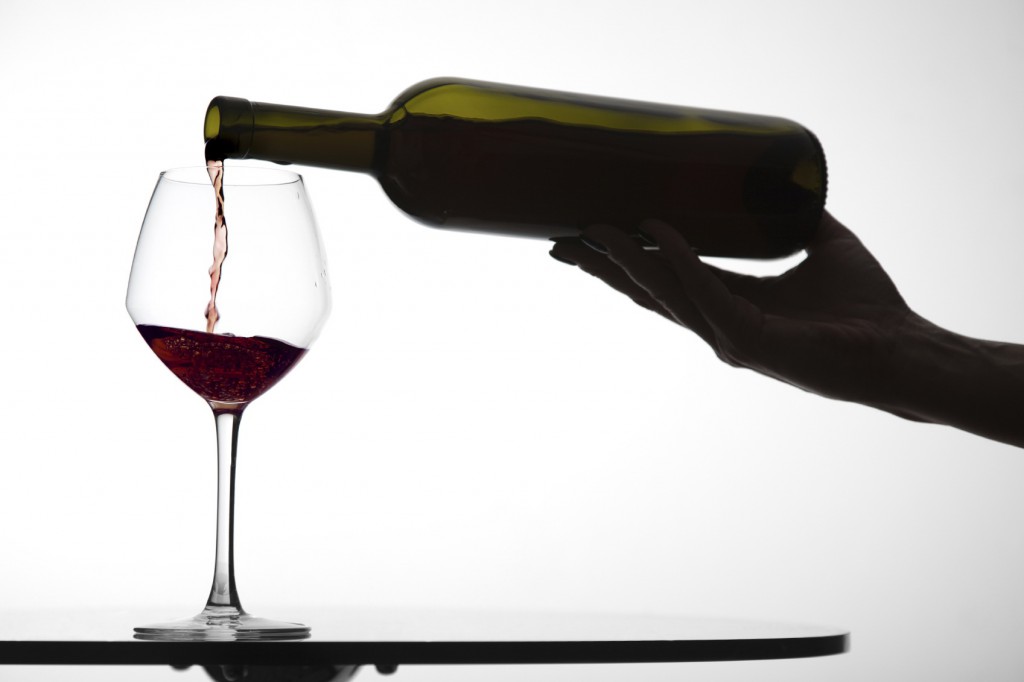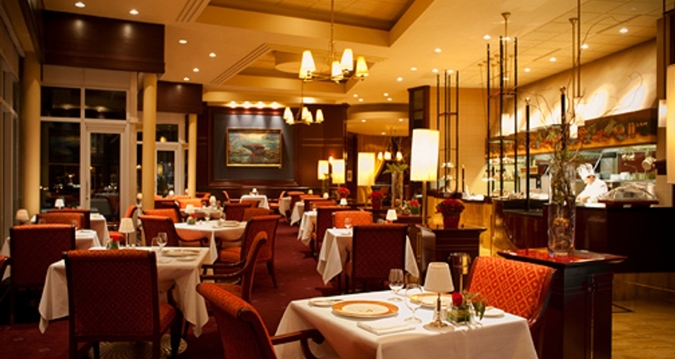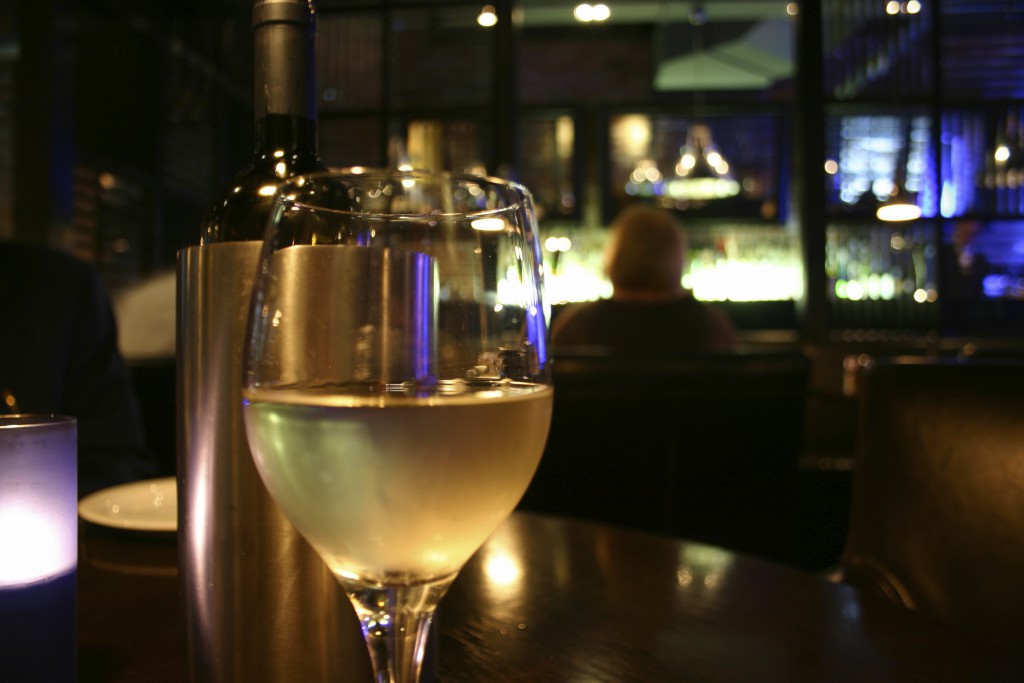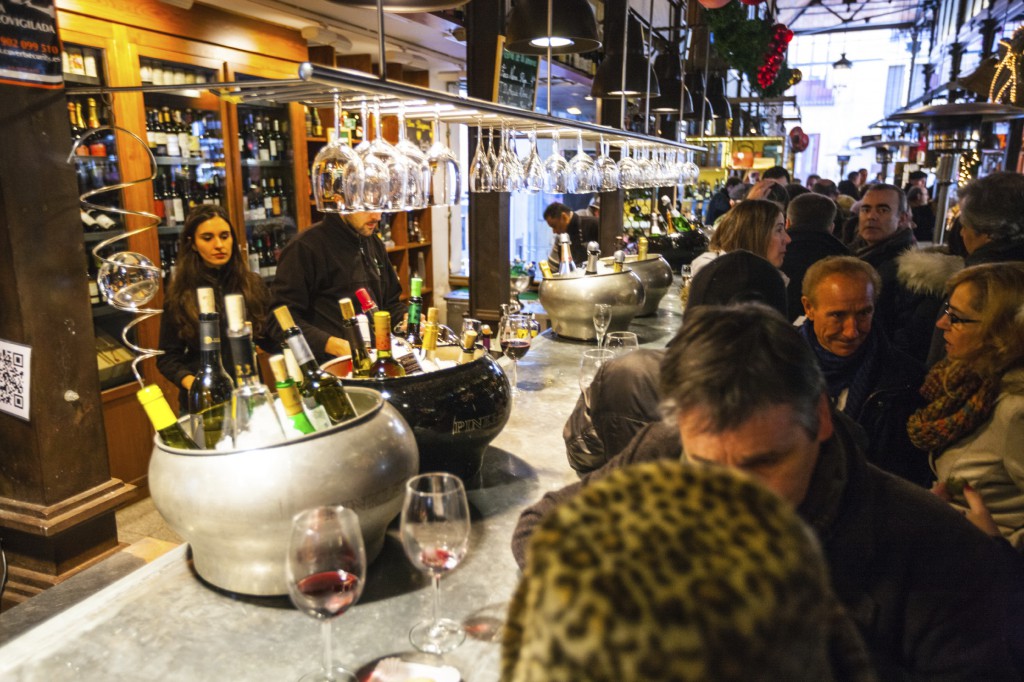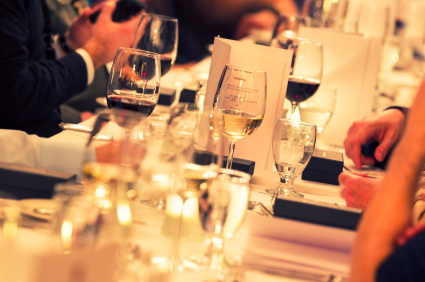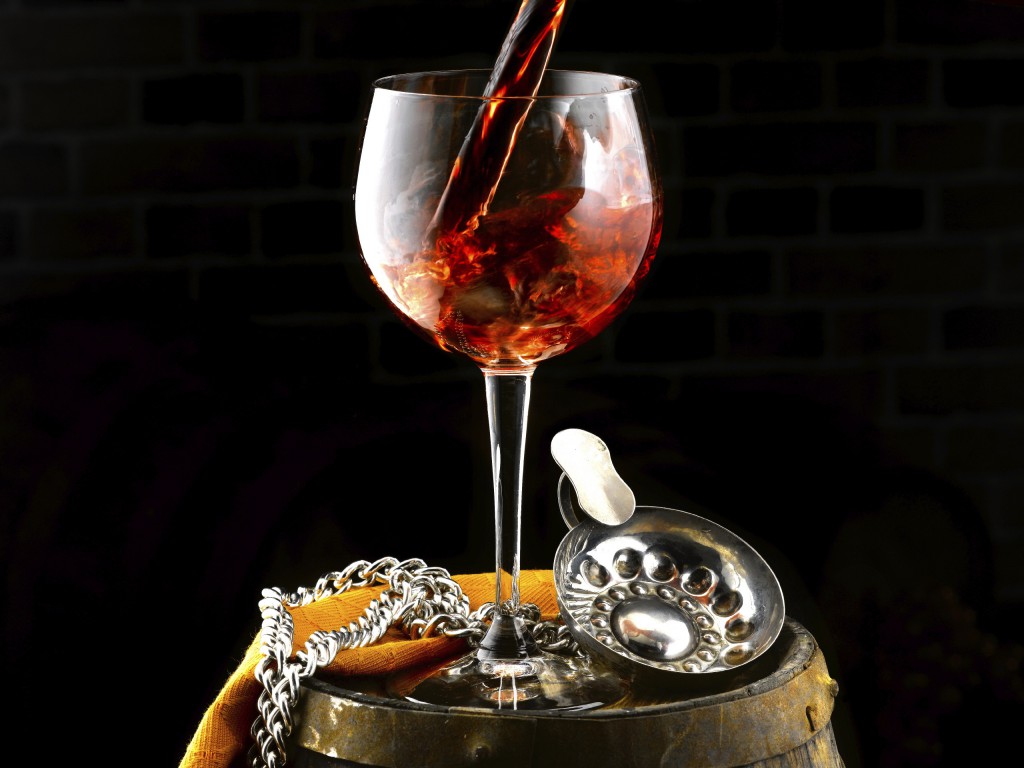Unless you count the time I handed out plates at a church supper, I’ve never worked as a waiter.
Of course, that hasn’t stopped me from commenting on the service in restaurants—particularly the wine service—as if I knew exactly what I was talking about.
Now, to stopper my leaking credibility, I’ve decided to work in a restaurant for a night.
Only the best would do, so I selected Le Baccara, an award-winning restaurant in Québec that offers haute French cuisine, with classic service. That would be just perfect for me, I thought—until I realized that as a server, I would have to deliver the classic service rather than receive it.
After some pleading (and plumping of my wine credentials), I got the approval of the manager for this experiment. I’d be working with the restaurant’s sommelier, Danielle Dupont.
Dupont suggests that I shadow her as a trainee for the first part of the evening, then work on my own.“This is going to be so cool!” I say with an eagerness unsuitable to a sommelier, who ought to be poise personified. Dupont chuckles and, before we hang up, advises me in her soft French accent to wear a jacket.
Even on the phone, Dupont embodies that mystique of a sommelier: the equanimity of an English butler, the warmth of a pediatric nurse and the knowledge of a winemaker.
The word sommelier dates back to the Middle Ages in France, when it referred to the principal wine taster of a religious order or a royal household. Since making, serving and drinking wine was serious business for both institutions, the position of sommelier was coveted.
Over the years royalty and religion became declining job markets. Sommeliers eventually became wine stewards of the people (well, the rich people) and worked mostly in fine restaurants. An 1889 issue of Harper’s magazine described the sommelier as one “who runs from table to table, laden with bottles, and distributes here and there strange liquids.”
Today, restaurant patrons are much more knowledgeable about wine; and so the role of the sommelier is changing accordingly. Instead of being aloof, sommeliers must quench wine lovers’ thirst for knowledge. Ideally, they’re fonts of information about wines from around the world—able to discuss grape-growing areas, châteaux, producers and vintages.
Of course, they also know which wines go best with the dishes on the menu. Sommeliers increasingly work alongside the chefs to create a complete experience for diners.
So why don’t more fine restaurants employ them? One reason is that only a few carry wine inventories large enough to need professional attention. Another is that restaurant owners aren’t aware of the bottom-line benefits of having sommeliers. Mostly, I think, it’s just a lack of knowledge about the position. In North America, being a sommelier still isn’t as widely viewed as a genuine profession, as it is in Europe.
Yet such is Dupont’s professionalism, you’d think she comes from generations of sommeliers. But her parents didn’t drink much wine, nor did many of the other people she knew in Kingsey Falls, the small village in Quebec where she grew up.
Still, as a teenager, she was drawn to the dazzling world of restaurants—a world that promised mini-dramas at every table, a chance to try on different personalities every night, days wit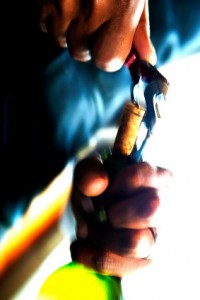 hout a set routine and skills that would allow her to travel. At first she focused on the food, as a server, and got a job at Le Baccara after successful stints at several other places. Then a few years ago, wine expert Jacques Orhon came to the restaurant to teach wine appreciation to its staff. Her passion for wine awakened, Dupont decided to take his in-depth course and become a sommelier.
hout a set routine and skills that would allow her to travel. At first she focused on the food, as a server, and got a job at Le Baccara after successful stints at several other places. Then a few years ago, wine expert Jacques Orhon came to the restaurant to teach wine appreciation to its staff. Her passion for wine awakened, Dupont decided to take his in-depth course and become a sommelier.
One of the many skills she learned was opening wine bottles with flare, which reminds me that I’ll be uncorking bottles in mid-air as patrons pause in their conversations to watch. So for two weeks before my big night arrives, I feverishly practice using a handheld corkscrew.
In my own kitchen, I always use a large lever model bolted to the counter—it makes opening bottles so easy that my manual skills have atrophied. I’m like a calligrapher who’s got used to writing on a laptop.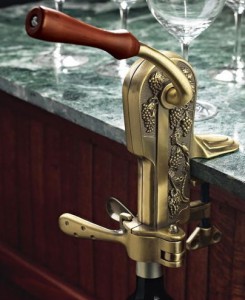
Real sommeliers must rely on the most basic manual screw model called the Waiter’s Friend. It takes effort to learn to use it without resorting to squeezing the bottle between your knees and yanking.
The first hurdle is cutting the foil cap off the top of the bottle, so you can get a clear shot at the cork. Most corkscrews come equipped with a knife that folds out, Swiss-army-style. I discover, though, that just pulling out the knife requires breaking a fingernail. I consider just leaving it sticking out, ready for action. But if I approach tables with my knife drawn, will diners interpret this as a sign of aggression? My first attempts make the foil cap flake off in silvery slivers, which I envision floating into the diners’ vichyssoise.
After some practice, I hold the bottle with my left hand and with my right hand, draw the knife around the seam just below the top of the bottle to cut off the foil cap. (If you’re a leftie, you may want to reverse your grip.) For corkscrews with center wormscrews such as the Waiter’s Friend, the trick is to position the point in the center of the cork and then pull it out straight. An antifriction coating such as Teflon on the screw can make this easier and smoother.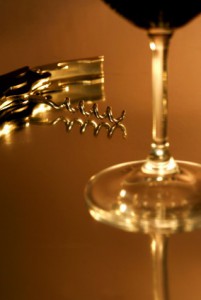
Fortunately, well-made corkscrews with sharply pointed wormscrews and a leverage device decrease the amount of effort required to just a couple of pounds of pull. Just before the corkscrew goes through the other end inside the bottle, I stop so that I don’t push little pieces of cork into the wine. Then I fit the notch of the corkscrew lever on the lip of the bottle and slowly wiggle the corkscrew up and extract the cork (trying not to grunt). Before pouring, I wipe off the top of the open bottle in case there’s any dust or small bits of foil.
Reassured, I decide to practice my delivery. I put on a jacket and stand in front of the bathroom mirror saying, “Good evening, I’ll be your sommelier tonight,” with varying modulations and accents. Trouble is, I can’t convince myself to order anything more than a beer. I can feel an old, familiar ball of panic rising from my stomach.
Before I started writing about wine, my anxiety dreams weren’t about falling off a cliff or being chased down an alley, they were about restaurant wine lists. In my nightmare, I’d be at some stuffy restaurant where I was handed a large leather-bound book that looked like a prop from The Lord of the Rings. Somewhere within it was the Secret of the Ideal Wine, the one perfect bottle. It was my task to extract this vinous Excalibur from the sacred tome, as a hundred pale eyes stared unblinking at me from the surrounding darkness.
I flipped helplessly through the pages, scouring the list for an answer. Then a grim man in black approached, wheeling a trolley table. It wasn’t stocked with cheese and port, as I had hoped; but with the Oxford Companion to Wine, back issues of The Wine Spectator magazine, a vintage guide, a dictionary, a world atlas and a magnifying glass.
“Would madam like a little pedantry with her wine?” the fellow asked with cheerful malice.
I pointed in blind confusion at the list. “I’ll take that,” I blurted.
“Oh, very good, ma’am: a box of the Sunset Red,” he snorted in triumph. “March was an excellent month for bagging it.” All those eyes silently watching me narrowed in accusation: I was exposed as a cheap, uncultured, algae-eating bottom feeder.
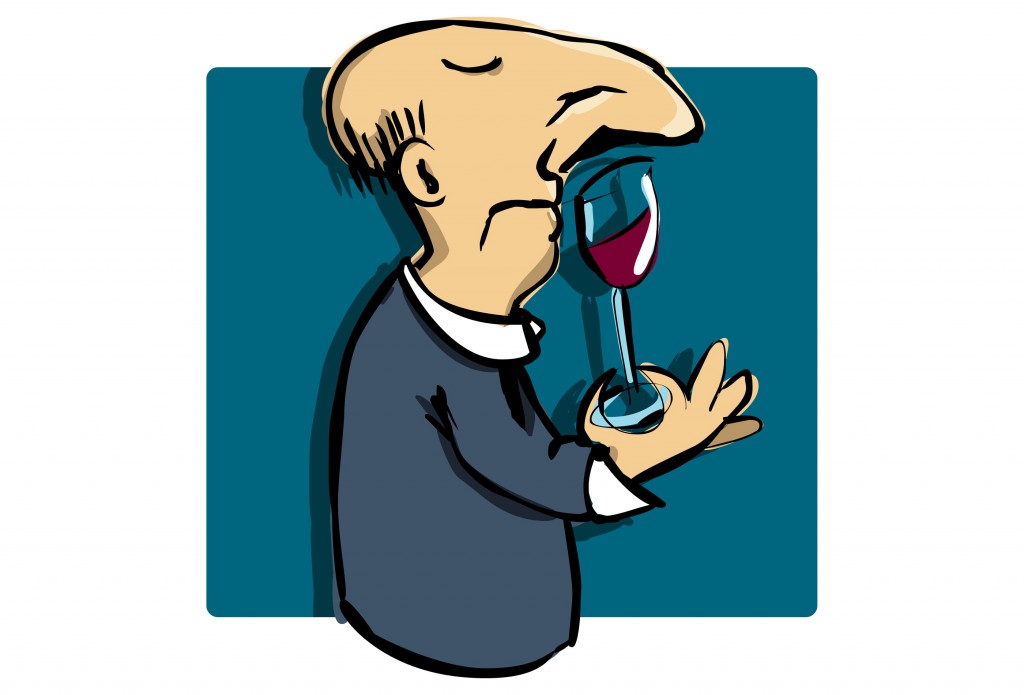
I know now that I wasn’t alone in that secret fear: most people would rather memorize the periodic table while getting a root canal than choose wine from a restaurant list. Even with years of experience behind me, I still dread it when my friends hand me the list.
I’m worried that I’ll pick a wine they won’t like, or worse, one that actually tastes awful. There’s so much riding on the choice that I think restaurants should tuck in a no-fault insurance policy. As I agonize over the list, my friends look like wilted dandelions. Frankly, I wish someone else would take on this task. I’d rather drink another person’s choice with quiet condescension than watch others sip mine trying to mask their distaste.
The fact is, so many wines are on restaurant lists that nobody has the time to taste them all. The diner’s dilemma isn’t helped by the fact that the traditional list is organized with all the creativity of a telephone directory: most just go by color, country and region. This gives you no sense of how the wines actually taste. That squirming, overwhelmed feeling comes from what I call the Vinous Flytraps—aspects of ordering restaurant wine that make you feel like a bug drowning in icewine.
Fortunately, some restaurants are adopting “progressive” lists: within the categories of sparkling, white, red and dessert, wines are listed either by style or by weight, from light-bodied to full-bodied. Baccara’s list has the traditional grouping of wines by regions, but Dupont helps diners find what they like. I’m looking forward to meeting her now that my big day has arrived.
I walk into the restaurant as the sun streams through the thirty-foot windows. Gold and burgundy hues give the long room the feel of a royal dining hall. Dupont meets me, 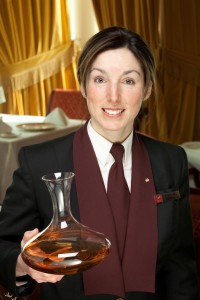 carrying five bottles in her graceful, piano-player hands. She’s a trim, five-foot-four, but her energy adds six inches to her height. Her big brown eyes glitter with playful anticipation.
carrying five bottles in her graceful, piano-player hands. She’s a trim, five-foot-four, but her energy adds six inches to her height. Her big brown eyes glitter with playful anticipation.
“Ah, my trainee has arrived,” she says. “Please carry this bottle, and follow me.”
We take the bottles to the counter at the other end of the dining room. Then she balances a large silver tray on her fingertips, places twelve long-stemmed glasses on it and moves off—quickly and silently, like a panther. I barely keep up with her, and I’m carrying nothing but my desire to make a good impression.
Dupont leads me through the kitchen, which is buzzing with evening preparations like the backstage of a theater. Someone whisks by with a large bowl of ice and we almost run into a cart of fresh fish being wheeled in. Glasses clink out of the dishwasher, and the kitchen is filled with quick exchanges of “Bonjour!” and “Salut!” trailing in the air like friendly sky-writing.
Of the seven waiters, Dupont is the only woman. Her role of sommelier was traditionally held by sneering men who used to terrorize the beaujolais crowd, though both gender and attitude have changed in many restaurants. In this traditional restaurant, however, Dupont is the New World. She’s knowledgeable but not arrogant—guiding the helpless rich who haven’t had time to learn about wine, but certainly have the money to spend on it.
Dupont also 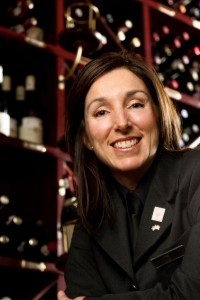 manages an inventory of some 17,000 bottles. These are stored in three cellars, one upstairs and two downstairs. We descend to the largest, a cavernous room containing row after row of bottles, a liquid library of grand old names.
manages an inventory of some 17,000 bottles. These are stored in three cellars, one upstairs and two downstairs. We descend to the largest, a cavernous room containing row after row of bottles, a liquid library of grand old names.
The second is smaller and temperature-controlled—it holds some of the oldest bottles, including an 1823 Château d’Yquem now worth more than $9,000. Dupont offers to let me hold the bottle, which is as brown as maple syrup with age, but I decline. I recall the bartender at another restaurant who accidentally dropped a bottle of Château Pétrus worth $10,000.
We go back upstairs to the third cellar, part of the dining room: a glassed-in, temperature-controlled room with dark oak shelves to display the bottles, candy-store style. On an oak turntable is an extraordinary vertical collection of Château Mouton-Rothschild from 1945 to 1997. It’s a visual treat since the label for each year was painted by a well-known artist: Jean Cocteau, Salvador Dalí, Henry Moore, Joan Miró, Marc Chagall and Andy Warhol.
In 1978, Montreal artist Jean-Paul Riopelle created two designs for the label, both based on the circular stains left by the bottoms of wine bottles. Rothschild couldn’t decide between them, so he used both, making bottles from that vintage even more valuable to collectors. In 1982, to commemorate what Robert Parker dubbed “the vintage of the century,” John Huston painted a watercolor image of a ram dancing joyfully next to a bunch of grapes, under a blue sky and orange sun.
For the 1999 vintage, artist Raymond Savignac again used “le gag visuel”: a frisky ram in a woolly orange sweater kicking up its hind legs. (The ram is a play on the château’s name—mouton is French for sheep.) None of the artists has ever been paid in cash; instead, all were reimbursed with five cases of the wine. That’s not a bad deal when you consider that the latest vintage retails for about $600 a bottle, and appreciates with maturity.
There were only two years when no original artwork was commissioned. In 1953, the label bore a portrait of the family patriarch, Baron Nathaniel Rothschild, to mark the centenary of the family’s purchase of the estate. And in 1977, a label with words and no art honored the queen mother, who had stayed at the château that year.
While I’m admiring the Mouton-Rothschild display, Dupont takes four bottles over to the part of the kitchen that’s open to the dining room. She and the chefs are creating the fall tasting menu. I salivate as I look at the plates with morsels of duck terrine, fig confit and warm spice cake; lobster à la nage in an emulsion of pepper squash and pistachio oil; crispy fillets of pan-fried Mediterranean sea bream, with a cèpe mushroom and artichoke tian; venison with truffle crust in a sweet-and-sour jus; and warm apple puff-pastries with an iced cinnamon parfait, topped with roasted pine nuts.
To match these dishes, Dupont has picked wines from France, Italy and California. She pours and we all try them along with nibbles of the food. She delights in diners who choose this tasting menu, trying a different wine with every course. These by-the-glass selections help to solve the classic restaurant dilemma of how to match wines to many different dishes. Another option, if diners are having only two or three courses, is a couple of half bottles rather than one full bottle. This helps in those situations where you’re having steak and your dining companion has ordered fish.
Some wines, such as riesling and pinot noir, can pair with a wide range of dishes because they are neither too full-bodied nor too light.
European wines generally tend to be more balanced and food-friendly than New World ones, which can be fruit-heavy and oaky. Of course, there are many exceptions to these generalizations, but these help to narrow the choices.Afterward, we head back to Dupont’s office, a crowded space that she shares with the mâitre d’, the banquet manager and several others. She sits at her computer to delete the out-of-stock wines and add the new ones.
“You’re familiar with these wines and can tell the guests about them?” she asks, pointing to the list.
I swallow. The notion that I can talk intelligently about some 450 wines is absurd.
“No problem,” I say.
At least I understand how she prices the wines on her list. The mark-up here is about twice the retail cost, though less at the high end. In the industry, that’s considered fair—especially in a fine establishment such as this. Aging wine, as Baccara does, also costs money: it ties up cash in bottles, inventory carrying costs, taxes and rent on storage, electricity to keep the stock at the right temperature and Dupont’s time to manage it. That’s why most restaurants don’t bother and why it’s generally best to choose wines from the list that are good when they’re young.
The high price of some restaurant wines is also due to other overhead costs: staff wages, wastage, glass breakage and replacement costs (because the same wine can often be more expensive when it’s time to replace the stock that’s been sold). In better restaurants, costs also include training their staff and buying good stemware. But high markups can also dampen wine sales, causing diners to choose beer or non-alcoholic drinks. Some diners now have drinks at home before going to the restaurant or simply don’t consider going out mid-week as restaurant dining is a save-up-for-the-weekend event only.
Most of us know roughly what the grocery store price is of chicken, fish or beef, so we can tell how much an establishment has marked up its food. But with wine, especially from small producers, the wholesale cost often isn’t known. That’s why some restaurants keep their selections obscure, offering wines you won’t find in the liquor store, so they can hide their markups—as much as three to four times the price. Robert Parker has described such prices as “legalized mugging.” Of course, many restaurants offer lesser-known wines simply to give diners a unique taste experience that they can’t have at home—and many others are indeed fair about their pricing.
In the hospitality industry, the adage is that customers will eat you poor and drink you rich. We now judge restaurants on the price of their entrées, but often the food isn’t priced fairly relative to its cost. Restaurants have long used spirits, liquors, coffee, tea and water as profit centres to cover the cost of food and overhead. Increasingly, they’re doing the same with wine. Though it’s one thing to pay $3 for a dollar’s worth of coffee, but quite another to pay $30 for a $10 wine. Wine drinkers end up the persecuted majority paying for those free-loading iced-tea types.
One problem of high wine prices in a restaurant is that they’re not evident in advance. Restaurants often post their menus in the front window, so we can check the prices and selection of the food, but they rarely post the wine list. That’s sprung on us once we’re inside and already a captive audience (like that overpriced popcorn at movie theaters).
Nor do restaurant reviewers help much. Most pay little attention to the wine, even though it’s half the enjoyment of a meal for many of us—and often more than half the bill. (In fact, it’s not unusual nowadays for the drinks to top the food, as a popular British restaurant guide found in a recent survey.) Many critics just throw in a line at the end of their review: “We had a nice bottle of cabernet for $50.” Most likely, this is because critics are foodies first, and wine lovers second (if at all). Still, such offhandedness is a disservice to both restaurants and diners.
A good idea is to do advance research on the web, since an increasing number of restaurants now post their wine lists online. Before leaving for the restaurant, take a few minutes to scan the list, maybe even look up reviews or scores online as well. Or if the wine list isn’t on the web site, call the restaurant to ask them to fax or e-mail it to you, or at least to discuss it over the phone. This is especially helpful if you’ll be choosing the wine for a large dinner group and makes you look like a real hero when the sommelier arrives. Not only do you make a quick choice, but you can even toss out a few comments about the region or vintage.
I use what I call the Wolf Blass Yellow Label Index: knowing the retail price of this Australian cabernet sauvignon, I can usually figure out the markups on the other wines. Higher up the scale, I use my Veuve Clicquot Non-Vintage Champagne Barometer. One of the reasons wine price is such a sticky issue is that no one wants to talk about it. At a business event or a special celebration, who wants to look cheap? And at a romantic dinner, few of us are willing to declare out loud just how much we’re willing to pay for love.
So we thoughtfully peruse the whole list as if we could afford it all—we’re just not quite in the mood for the $2,200 Domaine de la Romanée-Conti tonight, thank you. Many people first eye the cheapest bottle on the list, but hate to look like penny-pinchers, so instead they order the second-cheapest bottle (which was probably the cheapest bottle until last week, when the restaurant jacked up the price).
Knowing this is a delicate situation, I ask Dupont how to handle it just in case it comes up tonight. After all, the wines on her list run from $40 up to $10,000-plus. How do I guess how much a diner might be willing to spend? Do I look at the man’s cuff-links, the woman’s ring?
No, she says. When diners don’t give her hints about price by mentioning wines they’ve enjoyed in the past, she points to three choices at different prices—but so discreetly that only the person holding the list can see what she’s doing. This allows guests to save face by pretending it’s only the style of wine they’re interested in, rather than the cost. Savvy diners, she says, point to the prices themselves and ask something like “Do you have anything like this that’s full-bodied and well-aged?”
Good sommeliers are passionate about wines—all wines, from the moderately priced to the insanely expensive. So if you haven’t already decided on the wine you want when you’re dining out, ask your sommelier which wines she’s most excited about on the list. Is she fond of wine from a particular region, perhaps where she grew up? If so, she may have in-depth knowledge of these wines and a superior selection. Or just ask, “What can you tell me about this wine? Does it pair well with some of the dishes on the menu?”
Of course, sometimes you may find yourself in a restaurant where your instincts tell you that the server doesn’t deserve your confidence—when the sommelier has the night off, and you’re left with the guy who drinks flavored vodka. There are still ways to improve your odds of choosing a better bottle. Focus on the section of the list that seems best stocked, which is usually wine that complements the restaurant’s cuisine.
An Italian trattoria generally offers lots of chiantis, great with pasta; a red-velour-draped steakhouse will likely be strong on full-bodied cabernets that pair well with meat. If you’re dining in a winemaking region, such as Napa Valley or Niagara, local wines are often a good bet. They’re usually cheaper; they’ll complement the local cuisine; and the owner may know the producers and the wines.
Some of the best values come from lesser-known regions and grapes. Look for South African sauvignon blanc and German and Alsatian riesling. For reds, try South African and Australian shiraz; Oregonian, Canadian and New Zealand pinot noir; Chilean cabernet; Argentine malbec; Rhône red blends; Loire Valley cabernet franc; and Portuguese, Rhône and southern Italian and French red blends.
Conversely, some of the worst values are often the big-name grapes from big-name regions, such as California chardonnay and cabernet, or red blends from Bordeaux. That doesn’t mean you can’t drink wines from those regions, though; it just means you have to look for lesser-known areas and producers. In California, for example, try Paso Robles syrah or Sonoma zinfandel instead of Napa Valley cabernet.
By the time Dupont has given me these few guidelines, my feet are already tingling—it’s only 5 p.m. (I’m hungry too—my nervous energy has long since metabolized those tasting menu samples.) We head downstairs to the staff cafeteria where my hopes of nibbling on more foie gras are dashed: when you dine at Le Baccara, you can rest assured that your considerable bill doesn’t subsidize luxurious employee meals. After fortifying ourselves with something remarkably chicken-like, we go upstairs to freshen up before showtime. I repair my lipstick and Dupont straightens the bow tie of her tuxedo. (I’m wearing a starched white shirt and a black suit, an ensemble that looks as though it came from the 1988 Fall Undertaker Collection.)
We all meet in the kitchen—chef, maître d’, sommelier, servers—to review tonight’s specials. Sommeliers have to know the menu at least as well as the waiters do, since they must decide which wines best match the food. Dupont reviews the wines by the glass and some of the servers ask questions. It’s going to be a busy night; the maître d’ tells us that the restaurant is fully booked. Then it’s over. Thankfully, there’s no group hug, but we all do wish each other “Good service!” I’m reminded of the ancient Roman soldiers with their chant “Strength and honor!” before battle.
For the first hour or so, I’m just trailing Dupont. This is like being a passenger in a Mercedes on a country drive: the ride is so smooth and you’re so caught up with admiring the scenery, you don’t really pay attention to how the driver negotiates curves in the road. To watch Dupont in action is to believe that some people are just born with effortless grace. She deftly handles tired tourists, flirting businessmen, chi-chi gold-draped women and nervous dating couples.
I follow her to a party of four who’ve been studying the menus for about ten minutes. “Good evening,” Dupont says warmly. “Have you had a chance to look at the wine list?”
Their glances ricochet nervously from one to another and then back up to her, seeking help. Soothingly, she asks them if they’ve chosen their meals yet—it seems they’re all having different game dishes. Leaning slightly toward the man with the list, Dupont indicates a few wines on it and briefly describes how they would complement their meals. Although Dupont’s knowledge runs deep, she doesn’t get too esoteric with her descriptions: she knows that most customers aren’t trying to earn a sommelier certificate over dinner. Still, if she senses that the diner is interested, she likes to tell a story about the wine—the sun-drenched hillside where the vines grow, the family that runs the winery.
After the quartet’s spokesman makes his choice, she tells them that the wine has an earthy character that will dance a duet with their game. They seem pleased. Then without missing a beat, Dupont asks if they’d like to start with a glass of champagne. Sold.
While they’re enjoying the bubbly, Dupont presents their bottle. Like all good sommeliers, when she presents it to the host, she confirms the grape, vintage, winery and region. This isn’t as standard a practice as it ought to be; some waiters do the Vintage Shuffle, either intentionally or not. You order a wine from a certain year and you’re brought a different one. The year may not sound like a big deal, but it can make a real difference for wines from cool climate regions, where the weather can vary drastically from year to year.
For example, French wines taste mostly of acid, tannin or oak in bad years: there’s not enough fruit to balance the wine because the grapes didn’t ripen fully. Even New World regions sometimes have years that are better than others. Older wines, as well, may taste faded if they’re well past their prime.
If you do get a wine from a different year than the one you ordered, your server should point out the fact to you. That way, you can decide whether you want the alternative bottle or if you’d rather a different wine. If it’s a worse year, the restaurant should discount the bottle. But if they only have a better vintage, rather than the one advertised on the list, they should charge you the same price as for the one you ordered.
Some restaurants also capitalize on the fact that diners may recognize the names of the big châteaux but haven’t memorized a fifty-year vintage chart. So you may think the Château Latour will be spectacular, since it’s certainly priced that way; but it actually comes from a mediocre year. Lists that don’t even mention the vintage are highly suspect. Either the owner doesn’t know or care, or he’s trying to pass off inferior goods at high prices.
Beware too of a so-so producer from a prestigious region, such as Tuscany, Bordeaux or Châteauneuf-du-Pape. No region’s wines are 100 percent fantastic, nor are one producer’s wines. You may recognize and respect the Mondavi name from California; but that winery, like many others, makes wines that range from the high-end Robert Mondavi Reserve to the lower-end Mondavi Woodbridge. Remember, too, that new management or a new winemaker can make a big difference at a winery, pro or con—but the product’s price on restaurant lists may take a while to register such a change.
Other people are lured not so much by prestigious names as by awards, taking The Wine Spectator honours as gospel. The magazine’s restaurant-list awards have three levels, beginning with the Award of Excellence for offering at least a hundred well-chosen labels. Next is the Best of Award of Excellence for places that have 400 or more labels; these should include selections from several vintages of top producers and strengths in specific regions. Wines that harmonize well with the menu are also considered. But the Grand Award is given only to establishments with a hefty inventory, and at least 1,250 different labels, including older vintages, rare wines and large-format bottles. Only those considered for this last award are actually visited by Spectator staff; the rest are chosen based on the restaurant’s own description of its menu, wine list and wine program.
For restaurants, waiting for these awards to be announced is like waiting for Moses to come down from the mountain: first there’s a lot of speculation and then everyone scrambles frantically to see what’s on the tablets. The tough criteria discourages those without good lists from even applying, but some thirty-five hundred around the world do every year and 80 percent of them get one of the awards. Le Baccara has won the Spectator’s Best of Award of Excellence for several years.
Now it’s time to actually open the wine for the diners. To my relief, Dupont rests the bottle on an elegant wooden pedestal near the table. Evidently, the mid-air corkscrew act won’t be required of me tonight. Still, I wish it were customary to open the bottle out of sight behind the bar or in the kitchen, rather than near the patron’s table. But that custom has its roots in the bad old days, when unscrupulous restaurateurs might try to pass off Mateus as Margaux.
Hence the sommelier’s little silver cup, called a tastevin, was traditionally worn on a chain around their necks for a practical purpose, not because of an odd passion for ashtray accessories. However, this practice has all but disappeared. Patrons are more informed and some get nettled at the sight of the sommelier nipping into their expensive bottle. Dupont still does taste, from a small glass, old or rare wines that need decanting, but not the ones that customers drink right away.
Dupont pours an ounce or so for the host to try. This tasting ritual isn’t to embarrass anyone or for showmanship, but to check the wine’s quality. The man nods his acceptance and Dupont pours for everyone.
As we move away to the side of the room, I notice that Dupont constantly monitors all twenty-five tables without being obvious about it. (I’m trying to learn the art of invisible service, but have so far only mastered arranging myself like a tall ornamental shrub.) “A good sommelier knows when to approach a table,” she says. “You don’t want to interrupt a conversation, and yet the service must flow at the right pace. And you must also know how to break off gently with customers who want to chat, because if you spend too much time with one table, others suffer.”
It’s 8 p.m. now, the time appointed for me to flap my tiny wings. Dupont gives me a firm, motherly nudge. “Be confident, you are the sommelier,” she whispers.
Wishing I had drunk some liquid courage, I approach my diners. The foursome, two big burly fellows and their equally stout female companions, are sitting at a table beside the window. One of the men has the wine list, but his back is to me. I’d have to be Spider-Woman, crawling down the wall beside him to get to his right, the traditional side for serving customers. What to do?
Then I recall Dupont’s advice: try not to frighten customers by suddenly looming up over their shoulders. I know I don’t like it when sommeliers hover over me as I decide on the wine. I can’t imagine a scowling chef standing beside me as I hesitate between the scallops and the steak. I approach him from the left. Fortunately, this man knows what he wants—a big Bordeaux, a 1961 Château Talbot, at $500. Ka-ching.
Nodding respectfully and withdrawing, I mentally scold myself for not asking to be in on the tips. In fact, Dupont doesn’t share in the tips either—she’s on salary, as are many sommeliers in fine restaurants. This reduces their incentive to sell every diner the liquid equivalent of a Porsche.
As I bring out larger stemware on the silver tray, I wonder when that tremor developed. The liteau, a white linen napkin, is draped over my right forearm for classic French service. I’m afraid it’s going to drag all the cutlery and dishware on the table with it as I swoop in to set the glasses in front of the diners. But somehow I place them, even though they wobble like tops before stabilizing.
Next, I present the bottle to Mr. Big Bordeaux, and he nods curtly. I take it to one of those handy pedestals to open it, but realize I’ve got a toughie after all: red wines here are brought from the cellar lying down in wire baskets so that the bitter sediment at the bottom doesn’t mix in with the wine. It’s tricky getting the bottle out of the basket to pour it without tilting it upright or dribbling the wine. (Red wine seems to have a magnetic attraction to white linen tablecloths and shirts.) I almost pour the man’s sample into his water glass, but just in time manage to inch it over into his wine glass.
He nods, so I make my way around the table, serving first the women, then the men. Finally, I return to the host and fill his glass to the one-third level that’s considered ideal: the empty space allows drinkers to swirl the wine around and appreciate its aromas. I discover that pouring wine while standing three feet above the glasses is vastly different from doing it sitting down: it’s difficult to tell how much you’ve filled them. I have an urge to check the levels by squatting down to table height, like a golfer on the putting green.
I’ve nailed every pour and feel like a gymnast who dismounts from the parallel bars with a backward flip and a perfect landing. I stand over the table like a beaming penguin, expecting the man to look up at me approvingly with a raised eyebrow and say, “Nice pour.” But somehow my virtuosity is lost on him.
Not on Dupont, though, who was watching carefully. Back at the bar, she has an appreciative smile and a warm word of praise for me. Also a tip: “You’re tall, so you tend to bend over. If you put your left hand behind your back, you’ll maintain a straight, clean line.” Uh-oh, I think—first, the aerial basket extraction, now I need one hand tied behind my back. What’ll be next: a blindfold? But I try it with the next pour and realize that she’s right.
Next, I serve a friendly couple who order an Alsatian riesling. While I open the bottle, they’re debating whether Alsace is in France or Germany. I bite my lip trying not to jump in uninvited, until the woman turns to me with the question.
“France!” I blurt out, like a kid who’s able to clinch the spelling bee. But I’m learning from Dupont’s diplomacy: since the man chose Germany, I add that the region has been part of both countries over the years, and its wines share similarities of style with each.
I’ve never felt so omniscient, even though I’ve answered much tougher questions in my writing. I realize that it’s easy to appear an expert with a wine library and the Internet at hand, but it calls for an entirely different kind of intelligence to draw upon that knowledge on the spot.
I long to play this game again, but my next couple isn’t interested: they just ask for the house white. Of course, at Baccara these are not the cheap and nasty house wines found in lesser establishments. The notion of the house wine has sadly declined from its honourable beginnings in Europe, when wines were often locally made. They were emblematic of the restaurant’s cuisine, giving a sense of the local culture on the table.
Today in North America, house wines are often the leftovers from the list: cheap and nasty stuff that you can use in a pinch instead of Liquid Drano. They are the vinous cousins to Anthony Bourdain’s Sunday buffets in Kitchen Confidential. Drinking them is like accidentally walking into a bad neighbourhood: you’ll get roughed up and robbed and will learn never to take that wrong turn again. Not only are they bad to drink, they’re also usually a bad buy—one of the biggest rip-offs on the list. Many restaurants price a glass at the full wholesale price of the entire bottle. With four to five glasses per bottle, that can be a 300 to 400 percent mark-up. The first bottle can pay the restaurant for the whole case.
Yet some industry experts estimate that as much as half the wine sold in restaurants is house wine. How do they get away with rapacious margins on such vile stuff? Well, for one thing, most of us don’t expect anything better. House wine is mostly about mindless convenience. We don’t have to analyze the wine list or pronounce trockenbeerenauslese. It’s much easier just to tell the waiter, “I’ll have a glass of your house white please.”
Yet it needn’t—and shouldn’t—be that way. With so many new regions making affordable wines, there’s no reason not to have good house wines. House wine, like bread, is one of the first ways we judge a restaurant. You can tell that the place cares about quality when its list gives not just the wine’s name (“Imported French” doesn’t count), but also its region and vintage. A good house wine should marry well with a wide range of dishes and have lively, balanced fruit flavours, without too much oak, acidity, tannin or even fruit—since all those can tire the palate and overwhelm the food. Le Baccara, for example, offers a crisp white wine from the Loire Valley and a charming red from southern France that are both reasonably priced.
After the house wine couple approves their wine, I continue working the floor. By now I’m feeling cocky. I bring a California cult cabernet to a blond woman and her girlfriend. I pour a sample, then pour for her friend, then top up Blondie’s glass. But as I pull back, my wrist twitches and I leave a telltale trail of crimson drips on the tablecloth.
“Oh, I’m terribly sorry,” I gasp.
Blondie blinks slowly without looking at me and purses her lips. “Sorry,” I mouth again silently, as though I’m in an underwater nightmare. The woman resumes talking to her friend, but in a hardened tone. I want to take her made-up little face in my hands, turn it toward mine and say, “Look, I’m really sorry, please forgive me!” For the first time I realize what it’s like to feel servile, dismissed.
At least she doesn’t call the maître d’.
My wound heals gradually as I work with other tables without incident, but I am still absorbed in own tragedy – perhaps this is why some diners offer nurturing comments. It’s almost 11 p.m. – the time when the kitchen closes, even though the restaurant remains open until the last diner leaves.
My feet feel as though they’ve been on a concrete treadmill for 34 hours, and the connecting tendons in my hips are tightening with exhaustion. (Though to complain would make me look like a young nun who hasn’t yet moved beyond the concerns of the body.) But Dupont looks as though she’s just woken up refreshed from an afternoon nap. I ask her to be merciful and fire me, and she laughs.
“You’ve had a good service tonight. Go home, sleep well and come back soon — as a customer,” she says. Lying in bed that night, I reread the entire evening in my mind, and I realize how much Dupont enhances the diners’ pleasure. So why aren’t there more sommeliers in fine restaurants?
Partly, it’s because only a few carry wine inventories large enough to be worthy of professional attention. And partly, it’s because restaurant owners aren’t aware of the bottom-line benefits of having sommeliers. But mostly, it’s a lack of regard for the position.
In this country, being a sommelier isn’t viewed as a lifelong profession, as it is in France and Italy, but rather as a part-time job to pay for college or to support writing a book. Maybe that’s because we, as diners, can’t yet distinguish between servility and service.
Undercover Sommelier
Natalie: Hi! I just want to give you the backstory on this story, ‘Undercover Sommelier’. It does take the approach of “A Day in the Life”. It’s an approach that I really like because I think it does give the writer and the reader a deeper, richer sense of the story and what is involve. I know, personally, I’ve always been on the receiving end of fine service … wine service in restaurants until I did this piece and worked on the floor. By no means is that representative of what it’s like day in the day out but I think it’s better than sitting and interviewing someone or watching people in action. I can liken it to the difference between being in the driver’s seat and being in the passenger seat. You challenge yourself a bit more and get more actively involved in the story.
My inspiration for this is a journalist, George Plimpton in the US. He went undercover and hid secret confessions of a number of professions where he became the thing he was writing about. If it was football or another sport, he was really able to dig in more than any other sports journalist had previous to that.
So for this story, I chose Le Baccara which is one of the few Five Diamond restaurants in the Ottawa, Gatineau, Quebec border area.
I did that deliberately because it made me feel ill to think about serving there versus a casual bistro. I know when I have that feeling in my gut, that’s a good thing. Face the fear and do it anyway. So I hope you enjoy this and here we go.


